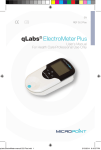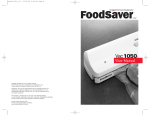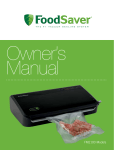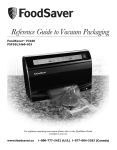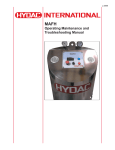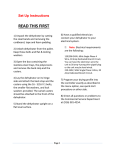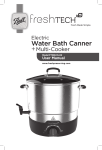Download Assembly Instructions and User`s Manual 26 sq ft.
Transcript
Assembly Instructions and User’s Manual 26 sq ft. Professional Dehydrator Style #FSGWCO5009 Please keep this instruction manual for future reference Customer Service: (888)815-4252, 9:00 am to 4:00 pm, Monday thru Friday, Central Standard Time or (888) 922-2336, 8:00 am to 10:00 pm, Monday thru Saturday, 9:00 am to 8:00 pm, Sunday, Central Standard Time or email [email protected] (Made in China) This unit operates most effectively when it is at least 2/3 full. TABLE OF CONTENTS Warnings......................................................................................................2 Parts List......................................................................................................3 How to use your new dehydrator..................................................................4 Fruit Drying Guide........................................................................................8 Vegetable Drying Guide...............................................................................9 Cleaning and Maintenance.........................................................................10 Warranty Information..................................................................................11 Page 1 of 11 WARNINGS IMPORTANT SAFEGUARDS When using any electrical appliance basic safety precautions should always be observed including the following. • READ ALL INSTRUCTIONS. To protect against risk of electrical shock, do not put appliance in water or other liquid. • • Do not touch hot surfaces. Use handles, knobs or oven mitts. • Close supervision is necessary when any appliance is used by or near children. This appliance is not recommended for use by children. • Unplug from outlet when not in use, before putting on or taking off parts, and before cleaning. • Allow to cool before putting on or taking off parts. • Avoid contact with moving parts. • Never put the unit near a hot burner or in an oven. • Do not operate the appliance or any other electrical equipment with a damaged cord or plug or after the appliance malfunctions, is dropped or damaged in any manner. Return unit to the nearest authorized service center for examination, repair, or adjustment. • Do not use outdoors. • Do not use appliance for other than intended use. • Do not let cord hang over edge of table or counter, contact sharp edges, or touch hot surfaces. • Do not pull on the power cord to disconnect. • Never plug in the appliance where water may flood the area. • Place the appliance on a firm and stable surface. • Ensure that the appliance is not placed close to the edge of the table, worktop, etc. where it can be pushed off or fall. • The use of attachments not recommended or sold by the manufacturer may cause fire, electric shock or injury. • Never use abrasive cleaning agents or abrasive cloths when cleaning the unit. • Only use the unit when completely assembled. • Do not leave the appliance unattended while it is running. • Before using for the first time, remove all packaging and wash parts. • Prior to unplugging unit, turn power off. • Do not place on or near hot gas, electric burner or in a heated oven. • Extreme caution must be used when moving an appliance containing hot oil or other hot liquids. • To disconnect, turn any control to “off”, then remove plug from wall outlet. • CAUTION: Turn unit on and off using timer or On/Off button only. Page 2 of 11 PARTS LIST Extension Cord Instructions: • A short power supply cord should be used to reduce the risk of becoming entangled in or tripping over a longer cord. • Extension cords are available and may be used if care is exercised in their use. • If an extension cord is used: 1. The marked electrical rating of the cord set or extension cord should be at least as great as the electrical rating of the appliance. 2. The cord should be arranged so that it will not drape over the countertop or tabletop where it can be pulled on by children or tripped over. 3. The extension cord should be a grounding type 3 wire cord. Part # Description Image Qty 1 Glass top touch control 2 Carrying handles 3 Glass door 1 4 12 non-stick trays 12 5 Internal LED lights 2 1 Page 3 of 11 2 HOW TO USE YOUR NEW DEHYDRATOR Assembly Instructions: CAUTION: BEFORE ASSEMBLING OR CLEANING THE DEHYDRATOR MAKE SURE POWER SWITCH IS TURNED OFF AND UNIT IS UNPLUGGED FROM ANY POWER SOURCE Assembly is a simple process. 1. Remove the drying racks and any loose items from the unit, then close the door. 2. Carefully place the dehydrator on its left side on top of a soft cloth or surface to prevent any scratches. NOTE: DO NOT PLACE ON THE RIGHT SIDE WHICH MAY CAUSE THE DOOR TO OPEN AND BECOME DAMAGED. DO NOT PLACE ON ITS FRONT OR BACK SIDE TO AVOID DAMAGING COMPONENTS. 3. Work on the front feet of the unit first. Locate the short feet bolts and the feet that attach to them.Insert the short feet bolts into the holes of the front feet of the dehydrator until they extend enough for you to attach the feet. 4. Tighten the short feet bolts with a screwdriver. 5. Insert the long feet bolts into the hole at the bottom of the unit they extend enough to attach the feet. 6. Tighten the long feet bolts with a screwdriver. 7. Carefully stand the unit to its proper upright position, making sure to hold the door closed to avoid damaging it. Operating Instructions: 1. 2. 3. 4. 5. 6. Make sure to remove all packaging. Wash and dry all parts prior to use. Plug in unit. Exercise caution if using an extension cord. Turn the power on by pushing the touch screen button located furthest right at the top panel. Remove racks and place food items to be dried onto the racks. Load the racks into the dehydrator. NOTE: The top three racks have a notch on the back to prevent the racks from touching the temperature sensor. 7. Make sure door is firmly closed. 8. NOTE: THE BUTTON AT THE FURTHEST LEFT IS AN INTERNAL LIGHT FOR YOUR CONVENIENCE. Begin programming the unit by pressing the clock button located second from the furthest left of the panel. Use the UP “^” and DOWN “v” buttons on the right side of the panel to set hours of operation (24 Hour Maximum). Press the clock button a second time to set minutes if desired (1 minute increments). 9. To set the temperature, press the button located to the right of the clock button. Use the UP and DOWN buttons to set the temperature (160 degree max, 50 degree min, 5 degree increments). 10.The dehydrator will automatically start after a short delay. You will hear 8 beeps at startup and then again when the temperature inside reaches the preset level. 11.If you have to pause during programming, the unit may start after a delay. This is normal, just continue finishing your programming as soon as possible. Page 4 of 11 HOW TO USE YOUR NEW DEHYDRATOR 12.The unit automatically stops when time set has been reached, but the power to the unit remains on. 13.Push the on/off button to turn unit off and unplug when not in use. Other Functions: This unit will automatically cycle through a display on the panel showing SET TIME, then TIME REMAINING for your drying, followed by the PRESET TEMPERATURE and then the ACTUAL TEMPERATURE inside the unit. Before Your First Use Dehydrating is the process of removing moisture from food to create a food with increased longevity and stability. How to Use: 1. It is important to dry at the correct temperature for the item you are dehydrating because vitamins within food can react negatively to high temperatures. Thus, pay careful attention to your temperature settings when drying fruits, vegetables and meats. 2. To ensure consistent results always dry similar thickness items. 3. Use food that is ripe, but not over ripe. 4. Drying times will vary based on type and thickness of food being dried as well as the relative humidity of the environment you are drying in. 5. Your dehydrator has a clear front for easy observation of drying progress so avoid opening the dehydrator excessively during use. Doing so will add time to the drying process. 6. Once your food is dried to the desired level, store it in a sealed container in a cool, dry place so that it does not reabsorb moisture. The dehydrated food will naturally have less moisture in it than the air around it and will absorb moisture if left out for an extended period. Note: storing dried food in a freezer is acceptable and will prolong the life of the food. Drying Fruit: 1. You can dehydrate any fruit that you enjoy. Let your own taste buds determine what you choose to dry. 2. It is important to wash fruits thoroughly to make sure all dirt is removed. 3. You can halve, chop or slice your fruit. It is up to you whether you want to peel your fruit. 4. You may want to pretreat your fruit before drying it. Doing so will help prevent it from discoloring due to natural oxidation. To pretreat, simply use lemon or pineapple juice and mix with water at a 1:1 ratio. Let fruit sit in mixture for a minimum of 15 minutes. Then remove the fruit and let dry for at least one hour prior to drying. There are commercial products also available for pretreating. 5. Place fruit on the dehydrator trays in a single layer making sure that the fruit is not touching or overlapping. 6. Please reference the fruit drying guidelines chart on page 10 for recommended drying times. 7. Once the fruit is dried to your liking, let sit for at least 30 minutes to cool. Store in a covered or sealed container in a cool, dry place away from direct light. Page 5 of 11 HOW TO USE YOUR NEW DEHYDRATOR Drying Jerky: Jerky is the most popular food to make in dehydrators. Making it yourself can save you money and allow you to create your own recipes. Use any lean meat you prefer such as beef, venison or fish. Safety Information: 1. Sanitation and a clean working area are essential. Wash hands thoroughly with warm soapy water prior to making jerky. 2. Meat should be frozen or refrigerated up until it’s ready to be used. 3. Do not allow raw meat to come in contact with the finished product. 4. Use a sanitizing solution or diluted bleach to clean all surfaces when done. 5. If marinating meat for whole meat jerky, always marinate in the refrigerator. 6. We recommend that you purchase a pre-packaged jerky spice and cure kit. Follow the instructions for proper seasoning and curing. Preparing Natural Jerky: 1. Natural jerky is sliced from bigger pieces of meat. Make sure meat is in the freezer until it is slightly hard to the touch but NOT frozen. This will help it slice more evenly. For best results slice meat ¼” thick. 2. While there are many recipes for making your own jerky, we recommend using a prepackaged jerky spice and cure kit. Follow the directions provided with the kit. 3. Place the meat on the drying racks making sure that they are not touching or overlapping. Jerky typically takes 4-8 hours to dry properly. 4. When done drying, remove jerky from the trays and let cool for at least 30 minutes. 5. Use paper towels to remove any excess oil and fat that may be on the jerky. 6. Store in a covered or sealed container in a cool, dry place away from direct light. 7. If you would like to store your jerky for more than 1 month it is recommended that you store in a refrigerator or freezer. Preparing Quick Jerky: 1. Quick jerky is made from ground meat. Use pre-packaged jerky spice and cure kit prior to drying and follow their instructions. 2. Once the mix is ready, place meat into jerky gun and carefully extrude the formed jerky strips making sure that the meat is not touching or overlapping. Jerky typically takes 4-8 hours to dry properly. 3. When the jerky is removed from the trays pat any excess oil or fat from the meat. Allow to cool for 30 minutes. 4. Store in a covered or sealed container in a cool, dry place away from direct light. 5. If you would like to store your jerky for more than 1 month it is recommended that you store in a refrigerator or freezer. Page 6 of 11 HOW TO USE YOUR NEW DEHYDRATOR Drying Vegetables: Unlike other food, vegetables lose a lot of moisture towards the end of the process. Therefore, they must be checked constantly near the end of the drying process. Preparing Vegetables: 1. Thoroughly wash your vegetables to remove any dirt. Peel the vegetable and slice it into even sizes so that they dry at the same rate. 2. Pretreatment is necessary for all vegetables in order to neutralize their natural enzymes. Specifically, steam blanching is the preferred method. 3. Bring a large pot that is filled 75% with water to a boil. Place your vegetables in a colander or basket and place carefully in the pot ensuring that there is a small gap for the steam to enter and cover with a lid. See vegetable drying guidelines chart on page 11. 4. When you are done blanching, place the vegetables in cold water to cool them off. 5. Remove the vegetables from the water and dry them. 6. Place them in a single layer on the dehydrator trays making sure that they are neither touching or overlapping. 7. To determine if your vegetables are done drying, take out a few pieces from different trays in the dehydrator. If you cannot break the vegetable in half with little effort, place them back on the dehydrator for more time. Repeat the process until finished. 8. Once the vegetables are dried to your liking allow to cool for 30 minutes. 9. Store in a covered or sealed container in a cool, dry place away from direct light. Drying Herbs: 1. Drying your own herbs is an excellent way to save money and ensure you have a plentiful supply year round. 2. Once you select which herbs you want to dry, wash them in cool water to remove any dirt. 3. Lightly dry them off and place them on the dehydrator trays. 4. Drying time for herbs is 30-90 minutes. Therefore, make sure to constantly check herbs for dryness every fifteen minutes at a minimum. They are considered dry when you can easily crumble them in your fingers. 5. Once herbs are dried to your liking allow to cool for 30 minutes. 6. Store in a covered or sealed container in a cool, dry place away from direct light. Page 7 of 11 FRUIT DRYING GUIDE Fruit Kiwi Pears Pineapple Strawberries Apples Rhubarb Peaches Cherries Grapes Prunes/Plums Nectarines Apricots Blueberries Cranberries Bananas Figs Preparation *Pretreatment Necessary Average Drying time No 2-6 hours Yes No 5-13 hours 4-12 hours No 4-12 hours Yes 2-9 hours No 4-9 hours Yes 4-10 hours (slices) 8-16 hours (halves or quarters) No 15-23 hours No 13-21 hours No 8-15 hours Yes 5-10 hours (slices) 8-16 hours (halves or quarters) Yes 8-16 hours No 9-17 hours No 10-18 hours Yes 6-8 hours No 8-15 hours Peel and cut into 1/4" to 1/2" thick slices Peel, core and slice 1/8" Peel, core and slice 3/8" Remove top. Slice 3/8" thick Peel, if needed. Core, cut into slices, 1/8" to 1/4" thick Trim and throw away leaves. Cut into 1/8" slices Peel if needed. Cut and remove pit. Quarter or 3/8" Remove pit and stem. Cut, chop or leave whole Cut in half or leave whole. Dry. Put in boiling water for 40 to 60 seconds. Put in ice water for skin to crack Quarter or halve and discard pit Cut and remove pit. Quarter or slice 3/8" thick Slice in half, remove pit, and cut in 3/8" slices Remove stem. Put in boiling water for 40 to 60 seconds. Put in ice water for skin to crack Remove stem. Put in boiling water for 40 to 60 seconds. Put in ice water for skin to crack Peel and cut into 1/4" to 3/8" slices Remove stem. Halve or quarter. Put whole figs in boiling water for 40 to 60 seconds. Put in ice water for skin to crack *Pretreatment - Use ascorbic acid mixture or lemon juice. Page 8 of 11 VEGETABLE DRYING GUIDE Vegetable Beets Carrots Celery Onions Tomatoes Potatoes Peas Corn Broccoli Mushrooms Peppers and Pimientos Cauliflower Green/wax beans Summer squash and zucchini Asparagus Preparation Cook until tender, peel, cut into 1/4" thick strips Peel and cut off each end, dice into 1/4" slices Trim edges. Cut in 3/8" slices Peel outer skin. Cut off top and ends. Cut into 3/8" slices Peel, if needed. Cut into slices 1/2" wide Peel and cut into 1/8" slices Shell Cut corn from cob and blanch Cut in pieces Clean and slice 1/2" thick Remove core, stem, and inner partitions cut into 1/8" strips Cut in pieces Take off ends and strings. Cut in 3/4" to 1" pieces Cut ends. Cut into 3/8" wide Cut in 3/4" to 1" pieces Steam Blanching Time Average Drying time N/A 2-7 hours 2-2½ minutes 2-8 hours 3 minutes 3-5 hours N/A 3-7 hours N/A 4-11 hours 5-9 minutes 2-8 hours 4 minutes 3-9 hours 1-1½ minutes 5-11 hours 2-2½ minutes 2-8 hours N/A 3-7 hours N/A 4-10 hours 3-6 minutes 3-8 hours 3-3½ minutes 4-11 hours 3½-4 minutes 2-6 hours 3-5 minutes 4-8 hours Page 9 of 11 CLEANING AND MAINTENANCE Cleaning and Maintenance: 1. Before cleaning check if the dehydrator is unplugged and cooled down. 2. Thoroughly wash trays with warm soapy water and dry completely. Do not submerse base in water. Do not let water get in fan. 3. Do not use metal brushes or abrasive cleaners when cleaning the dehydrator, because it can damage the surface. Page 10 of 11 WARRANTY INFORMATION ONE-YEAR LIMITED WARRANTY Your product is warrantied for one year from date of purchase against all defects in material and workmanship. Should your product prove defective within one year from date of purchase or receipt, return the unit, freight prepaid, along with an explanation of the claim. Please package your product carefully in its original box and packing material to avoid damage in transit. We are not responsible for any damage caused to the product in return shipment. Under this warranty, we undertake to repair or replace any parts found to be defective. This warranty is only valid if the product is used solely for household purposes in accordance with the instructions. This warranty is invalid if the unit is connected to an unsuitable electrical supply, or dismantled or interfered with in any way or damaged through misuse. We ask that you kindly fill in the details on your warranty card and return it within one week from date of purchase. Send warranty card to: Game Winner Dehydrator C/O CI PO Box 444 Two Rivers, WI 54241-0444 Page 10 of 11













